
The Oker is a river in Lower Saxony, Germany, that has historically formed an important political boundary. It is a left tributary of the River Aller, 128 kilometres (80 mi) in length and runs in a generally northerly direction.

The Harz is a highland area in northern Germany. It has the highest elevations for that region, and its rugged terrain extends across parts of Lower Saxony, Saxony-Anhalt, and Thuringia. The name Harz derives from the Middle High German word Hardt or Hart, Latinized as Hercynia. The Brocken is the highest summit in the Harz with an elevation of 1,141.1 metres (3,744 ft) above sea level. The Wurmberg is the highest peak located entirely within the state of Lower Saxony.
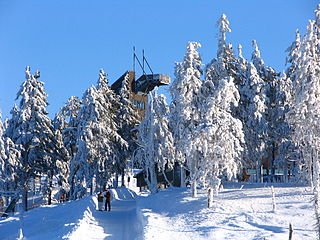
Goslar is a district in Lower Saxony, Germany. It is bounded by the districts of Göttingen, Northeim, Hildesheim and Wolfenbüttel, the city of Salzgitter, and by the states of Saxony-Anhalt and Thuringia (Nordhausen).

Goslar is a historic town in Lower Saxony, Germany. It is the administrative centre of the district of Goslar and located on the northwestern slopes of the Harz mountain range. The Old Town of Goslar and the Mines of Rammelsberg are UNESCO World Heritage Sites. Each year Goslar awards the Kaiserring to an international artist, called the "Nobel Prize" of the art world.
Lutter am Barenberge is a market town (Flecken) and a former municipality in the Goslar district of Lower Saxony, Germany. Since 1 November 2021, it is part of the town Langelsheim, of which it is an Ortschaft. It was the administrative seat of the former Samtgemeinde Lutter am Barenberge

The Harzburg, also called Große Harzburg, is a former imperial castle, situated on the northwestern edge of the Harz mountain range overlooking the spa resort of Bad Harzburg in Goslar District in the state of Lower Saxony, Germany. It was erected from 1065 to 1068 at the behest of King Henry IV of Germany, slighted during the Saxon Rebellion in 1073-75, and a century later rebuilt under Emperor Frederick Barbarossa and his Welf successor Otto IV, who died here in 1218.

Ilsenburg is a town in the district of Harz, in Saxony-Anhalt in Germany. It is situated under the north foot of the Harz Mountains, at the entrance to the Ilse valley with its little river, the Ilse, a tributary of the Oker, about six 6 miles (9.7 km) north-west of the town of Wernigerode. It received town privileges in 1959. Owing to its surrounding of forests and mountains as well as its position on the edge of the Harz National Park, Ilsenburg is a popular tourist resort. Since 2002, it is officially an air spa.
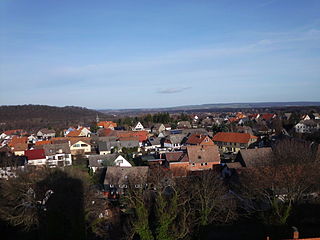
Vienenburg is a borough of Goslar, capital of the Goslar district, in Lower Saxony, Germany. The former independent municipality was incorporated in Goslar on 1 January 2014.
Werlaburgdorf is a village and a former municipality in the district of Wolfenbüttel, Lower Saxony, Germany. Since 1 November 2013, it is part of the municipality Schladen-Werla.

Stapelburg is a village and a former municipality in the district of Harz, in Saxony-Anhalt, Germany. Since 1 January 2010, it is part of the Nordharz municipality.

The Salzgitter Hills is an area of upland up to 322.9 metres (1,059 ft) in height, in the Lower Saxon Hills between Salzgitter and Goslar in the districts of Wolfenbüttel and Goslar and in the territory of the independent town of Salzgitter. The hills lie in the German federal state of Lower Saxony.
Sudmerberg is a quarter (Stadtteil) of Goslar in Lower Saxony, Germany, named after a prominent 354 m (1,161 ft)-metre-high hill to the east.

Oker is a borough (Stadtteil) of Goslar in Lower Saxony, Germany. Since 1952 a mining town in its own right within Wolfenbüttel district, it was incorporated into the Goslar municipality on 1 July 1972.
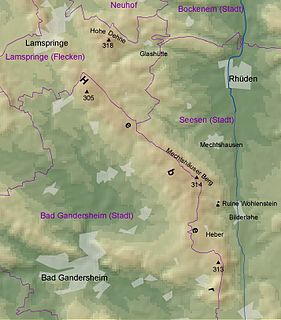
The Heber is a hogback ridge, relatively small in area and up to 313.5 metres high, in the Lower Saxon Hills within the districts of Goslar, Northeim and Hildesheim in the German state of Lower Saxony.

The Harlyberg, at 255.9 m above sea level (NN), is the highest hill of the Harly Forest, and rises in the district of Goslar in southeastern Lower Saxony, central Germany.

The Harly Forest is a hill range up to 256 m (840 ft) above NN in the district of Goslar in southeastern Lower Saxony, Germany.
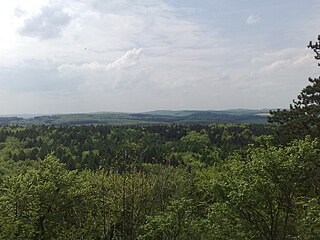
The Hainberg is a hill range, up to 299 metres high, northwest of the Harz Mountains in the eastern part of Lower Saxony, Germany.
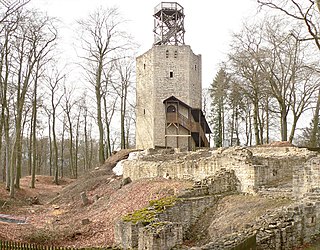
Lichtenberg Castle, also called the Heinrichsburg, is a ruined castle dating to the 12th century in the Lichtenberge hills near Salzgitter in the German state of Lower Saxony. The ruins are found south of and above the Salzgitter suburb of Lichtenberg on the steep summit of the Burgberg.
The Drei-Länder-Stein is a boundary stone at the tripoint of the German federal states of Lower Saxony, Saxony-Anhalt and Thuringia near the Großer Ehrenberg mountain in the Harz.

Bad Harzburg railway station serves the spa town of Bad Harzburg in Lower Saxony, Germany. It is the southern terminus of the Brunswick–Bad Harzburg railway, one of the oldest lines in Germany, and the eastern terminus of a branch line to nearby Oker station. Regional rail services are operated by Deutsche Bahn AG and Erixx GmbH.

















